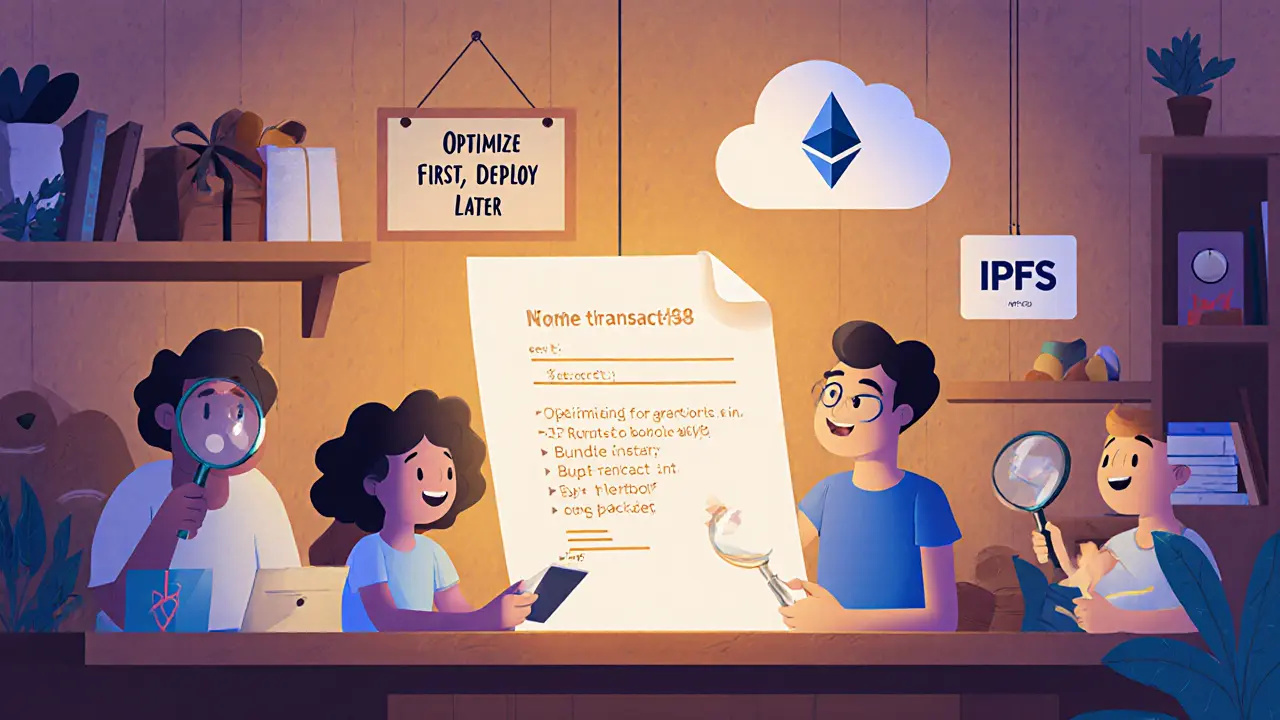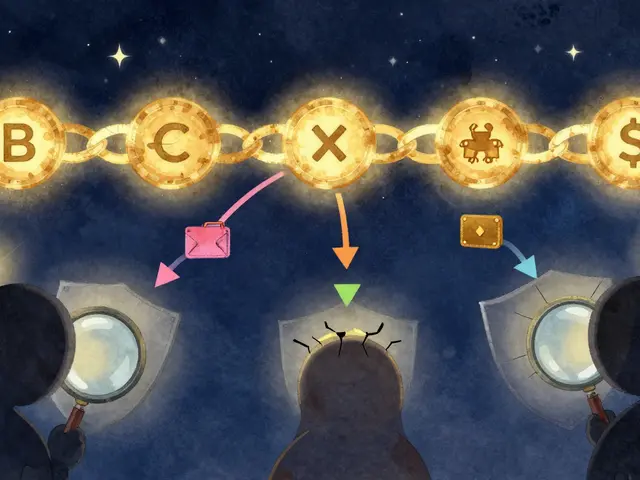Smart Contract Execution Cost Calculator
Estimate Your Costs
Results
Estimated Execution Cost
Approximate Gas Usage: 0 gas
When you deploy a smart contract, you’re not just writing code-you’re paying for every line of it to run on a global computer network. And that cost? It can swing from a few cents to over $10,000 in a single day. If you’re building a dApp, launching an NFT, or trying to automate a business process on blockchain, ignoring execution costs is like buying a car without checking the fuel price. You might get it running, but you won’t keep it on the road.
What Exactly Are Smart Contract Execution Costs?
Smart contract execution costs are the fees you pay to get your code processed and confirmed on a blockchain. These aren’t like bank fees or subscription charges. They’re more like paying for electricity to run a machine-every operation, every storage update, every calculation costs something. On Ethereum, this is measured in gas. One gas unit equals one computational step. The total cost is gas used × gas price (in gwei). A simple token transfer might use 50,000 gas. A complex DeFi swap? That could hit 2 million gas or more.
Other blockchains don’t use gas. They charge in native tokens-SOL on Solana, BNB on Binance Smart Chain, MATIC on Polygon. But the idea is the same: more work = more cost. And unlike fixed fees, these prices aren’t set in stone. They rise and fall based on how busy the network is.
Ethereum: High Cost, High Security
Ethereum remains the gold standard for security and decentralization. As of October 2025, it has over 8,800 active nodes spread across the globe. That’s why institutions, DeFi protocols, and high-value applications still choose it-even when the fees hurt.
Average execution costs on Ethereum mainnet range from $5 to $50 under normal conditions. But during peak times-like an NFT mint or a major protocol launch-it can spike to $150 or more. One developer on Reddit reported spending $12,000 to deploy a smart contract during a CryptoPunk minting event. That’s not a typo. That’s real.
Why does it cost so much? Because every node on Ethereum validates every transaction. That’s slow, but it’s also incredibly secure. If you’re handling millions in assets, you pay for that peace of mind.
There’s good news, though. The Dencun upgrade in March 2025 slashed layer-2 costs by 90% thanks to proto-danksharding (EIP-4844). Rollups like Arbitrum and Optimism now run at $0.005 per transaction. But if you’re deploying directly to Ethereum mainnet? You’re still paying the premium.
Solana: Speed and Sub-Cent Fees
If Ethereum is a luxury sedan, Solana is a Formula 1 car. It’s fast. It’s cheap. And sometimes, it breaks down.
Solana’s average transaction cost? $0.00025. That’s a quarter of a cent. For comparison, that’s less than the cost of a single emoji in a text message. It handles up to 100,000 transactions per second after the Firedancer upgrade in June 2025. That’s why gaming apps, microtransactions, and NFT marketplaces flock to it.
But here’s the catch: Solana has had multiple network outages in 2025. Three major ones in Q2 alone, totaling over 17 hours of downtime. One developer told me their NFT minting site went offline for six hours during a product launch. Users lost $2.3 million in failed transactions because the network just… stopped.
For apps where uptime matters as much as cost, Solana’s reliability is a gamble. If you’re building a payment system for a bank? Probably not the choice. But for a mobile game where players buy skins every few minutes? Perfect.

Binance Smart Chain: The Budget EVM
Binance Smart Chain (BSC) is Ethereum’s cheaper cousin. It’s fully compatible with Ethereum’s Virtual Machine (EVM), so you can reuse your existing code. And it costs less than $1 per transaction-usually under $0.10.
That’s why so many startups and DeFi projects started here. But there’s a trade-off: centralization. BSC runs on just 41 validator nodes, all controlled by Binance or its partners. That makes it faster and cheaper, but also more vulnerable to censorship or manipulation.
It’s a good fit if you’re building something that doesn’t need bank-level security-like a simple token swap or a community loyalty program. But if you’re handling user funds or regulatory-sensitive data, the reduced decentralization is a red flag.
Polygon: Ethereum’s Scalable Sidekick
Polygon isn’t a rival to Ethereum-it’s its best friend. It’s a layer-2 scaling solution that connects to Ethereum, inheriting its security while cutting costs by 95%.
With Polygon’s CDK stack released in Q2 2025, you can now create custom chains with fees as low as $0.003 per transaction. That’s cheaper than most credit card processing fees. And because it’s EVM-compatible, developers don’t need to learn new tools. You write in Solidity. You deploy the same way. You just pay pennies.
Over 1,200 new projects jumped to Polygon in just three months after the CDK launch. Why? Because users won’t abandon your app if every interaction costs a fraction of a cent. And you don’t need to sacrifice Ethereum’s security.
Polygon is the sweet spot for most dApps today: low cost, high reliability, full Ethereum compatibility.
Hyperledger Fabric: Enterprise-Only, High Upfront Cost
If you’re not a startup, and you’re not building for the public internet, Hyperledger Fabric might be your only option. It’s not a public blockchain. It’s a private, permissioned network used by banks, governments, and large corporations.
There’s no gas. No public miners. You run your own nodes. Costs are fixed and predictable-but only after you pay $25,000 to $100,000 to set it up. That’s for configuration, compliance, security audits, and integration with legacy systems.
Once it’s running, each transaction might cost less than $0.01. But you’re not paying per use-you’re paying for the whole infrastructure. That’s why 41% of enterprise blockchain projects use Hyperledger, according to Deloitte’s 2025 survey. It’s not for everyone. But for regulated industries? It’s the only way to get audit trails, identity control, and guaranteed privacy.

How to Reduce Smart Contract Costs
Even on the cheapest chains, bad code can blow your budget. A poorly written contract can cost 10x more than it should. Here’s what works:
- Minimize storage writes. Every time you store data on-chain, it costs 20,000-50,000 gas. Use off-chain storage (like IPFS) for images, documents, or metadata.
- Batch operations. Instead of 100 separate transfers, do one batch. Saves 70% in gas.
- Use efficient data types. Use uint8 instead of uint256 when you don’t need big numbers. Every byte saved reduces cost.
- Optimize loops. Avoid loops that run over large datasets. Use events or off-chain indexing instead.
- Test on testnets. Deploy on Goerli or Sepolia first. See how much gas your contract uses before going live.
OpenZeppelin’s gas-optimized libraries are cloned over 1,200 times a week on GitHub. That’s not luck. That’s industry standard practice. Developers who skip optimization? 62% of them fail within a year, according to Gartner.
What Should You Choose?
Here’s a quick guide based on your use case:
- High-value DeFi or institutional use? Ethereum mainnet or Ethereum layer-2 (Polygon, Arbitrum).
- Mobile game, NFT marketplace, or microtransactions? Solana or Polygon.
- Enterprise system with compliance needs? Hyperledger Fabric.
- Startup with limited budget? Polygon or BSC (but be aware of BSC’s centralization).
- Want to future-proof your project? Build on Ethereum layer-2. That’s where the industry is heading.
There’s no single best chain. There’s only the best chain for your use case. The key is matching cost, speed, and security to your real needs-not the hype.
What’s Next?
By 2026, Gartner predicts 75% of enterprise blockchains will use hybrid fee models-fixed monthly fees plus small usage charges. That means costs will stabilize. By 2028, Forrester says smart contract execution fees will be negligible for most businesses.
Right now, we’re in the messy middle. Fees are volatile. Tools are evolving. But the trend is clear: costs are falling, efficiency is rising, and the barrier to entry is dropping.
If you’re just starting out, don’t try to build on Ethereum mainnet. Start on Polygon. Learn how to write efficient code. Test everything. Then scale up when you’re ready.
Smart contracts aren’t magic. They’re code. And code has a price. Know the price. Optimize it. Then build something that lasts.
Why are Ethereum smart contract fees so high?
Ethereum fees are high because every node on the network validates every transaction. This ensures maximum security and decentralization, but it’s computationally expensive. Network congestion-like during NFT mints or DeFi surges-drives gas prices up. Even with the Dencun upgrade reducing layer-2 costs by 90%, mainnet execution remains expensive for direct deployments.
Can I avoid paying gas fees entirely?
You can’t avoid fees on public blockchains-they’re how miners or validators get paid. But you can shift the cost. Some apps use “gasless” transactions where the dApp sponsor pays the fee for users. Others use layer-2 solutions like Polygon, where fees are so low they’re practically free. Still, someone, somewhere, is always paying for computation.
Is Solana really cheaper than Polygon?
Yes, Solana’s average fee is lower-$0.00025 vs. Polygon’s $0.003. But Solana has had major outages in 2025, while Polygon inherits Ethereum’s security and has near-perfect uptime. Cheaper isn’t always better if your app goes offline during peak usage. For most dApps, Polygon’s balance of low cost and reliability is more valuable.
How do I estimate the gas cost of my smart contract before deploying?
Use tools like Remix IDE or Hardhat with the gas reporter plugin. Deploy your contract on a testnet like Sepolia and simulate real user actions. The tool will show you exactly how much gas each function uses. Aim for under 1 million gas for complex contracts. Anything over 3 million is a red flag for optimization.
Do smart contract costs affect user adoption?
Absolutely. A 2025 study showed that if a transaction costs more than $0.50, user engagement drops sharply. Apps with fees under $0.01 see 5x more daily active users. That’s why NFT projects moved from Ethereum to Polygon-users weren’t willing to pay $50 to mint a digital image.
What’s the cheapest blockchain for deploying a smart contract?
For public chains, Solana is cheapest at $0.00025 per transaction. But if you need reliability and EVM compatibility, Polygon is the better choice at $0.003. For enterprise use, Hyperledger Fabric has near-zero per-transaction costs-but requires a $25,000+ setup. The cheapest option depends on whether you care more about price, uptime, or compliance.
Are there hidden costs beyond gas fees?
Yes. Smart contract audits cost $5,000-$50,000. Legal compliance (like SEC disclosures) adds $7,500+ per project. Developer time to optimize gas usage? That’s often the biggest hidden cost. Many teams spend months learning how to write efficient code. Ignoring these can make your project fail even if gas fees are low.







emma bullivant
October 28, 2025 AT 06:47soooooo... solana’s cheaper but crashes like my old windows xp?? 😅 i just want my nft mint to work, not become a horror story
Jessica Smith
October 28, 2025 AT 14:25Anyone still using Ethereum mainnet for anything but bragging rights deserves to lose money
Karla Alcantara
October 29, 2025 AT 05:26I love how this post breaks it down like a roadmap instead of a sales pitch. Polygon really is the sweet spot-low fees, no drama, and you don’t have to relearn everything. I migrated my whole NFT project there last month and my users haven’t complained once. Seriously, if you’re starting out, don’t overthink it. Just go Polygon. 🌱
Will Atkinson
October 29, 2025 AT 11:36Y’know what’s wild? People act like gas fees are the enemy… but honestly, if your contract costs $0.003 and your user base grows to 10M, you’re still paying $30k/month. That’s not free-it’s just cheap enough that you forget to count it. I learned that the hard way when my dev team didn’t optimize loops and we burned $12k in a weekend. Lesson: cheap ≠ free. Always audit. Always test. Always sleep well.
Also, love the OpenZeppelin mention. Those libraries are like the IKEA of smart contracts-simple, sturdy, and you don’t have to carve your own wood.
And Solana? Yeah, it’s fast. But when your entire marketplace goes dark during a 10k-drop because a validator node overheated? You don’t get to say ‘oops’ and refund users in ETH. You get a PR nightmare and a GitHub repo full of angry issues.
Polygon’s uptime is 99.98% this year. Solana’s? 97.2%. That 2.8%? That’s your users walking away forever.
And Hyperledger? Don’t even get me started. I worked at a bank that spent $80k setting it up… then realized they needed to manually approve every single transaction because ‘regulations.’ So we ended up with a glorified Excel sheet with blockchain branding. 😅
Bottom line: choose based on your users, not your ego. If your app’s for grandma buying digital art? Polygon. If it’s for a hedge fund trading $50M in tokens? Ethereum L2. If it’s for a game where kids buy virtual hats? Solana, but only if you have a backup server.
And please, for the love of all that is decentralized-don’t store JPEGs on-chain. Use IPFS. Please. I beg you.
Stephanie Alya
October 31, 2025 AT 02:43lol at people paying $50 to mint a pixel cat. we’re not in 2021 anymore. 😒
olufunmi ajibade
October 31, 2025 AT 21:10Why do we keep pretending blockchain is for the people when the real winners are those who can afford to pay $10k in gas? This isn't innovation-it's a luxury tax disguised as tech. I've seen Nigerian artists lose weeks of income because their mint failed. Where’s the justice in that?
Peter Schwalm
November 2, 2025 AT 20:09Great breakdown! One thing I’d add: always test your contract’s gas usage with real user flows-not just the happy path. I once had a contract that looked fine in tests, but when 200 users tried to claim a token at once, it blew up because of nested loops. Used Hardhat’s gas reporter, cut it from 4.2M to 890k gas. Huge win.
Also, if you’re using Solidity, always use unchecked{} blocks for simple math where overflow isn’t possible. Saves hundreds of gas per operation. Tiny changes, massive savings.
Sarah Hannay
November 3, 2025 AT 16:34While the cost analysis is technically accurate, the underlying assumption-that blockchain should be optimized for low fees-is fundamentally flawed. The purpose of decentralized systems is not to replicate Web2 efficiency, but to establish trustless, immutable, and censorship-resistant infrastructure. Sacrificing decentralization for cost savings undermines the entire value proposition. One must ask: are we building for users, or for venture capital’s quarterly metrics?
Richard Williams
November 4, 2025 AT 15:22For anyone new to this: don’t try to be a hero and deploy on mainnet. Start on Sepolia, use Remix, and run gas reporter on every function. I’ve mentored 12 devs this year-all of them blew their budget on the first deploy. One guy spent $800 on a ‘hello world’ contract because he didn’t know storage costs 20k gas per write. Don’t be that guy.
And yes, Polygon is the real MVP. I’ve got three dApps on it. Zero complaints. Zero outages. Users love it. Just… don’t use BSC if you care about your users’ funds. Binance controls the validators. That’s not decentralization. That’s a bank with a blockchain logo.
Cyndy Mcquiston
November 4, 2025 AT 18:02Why are we even talking about Solana? It’s a US project. We should be supporting American tech. Ethereum is too slow. Polygon is foreign. Solana is the future. End of story.
Abby Gonzales Hoffman
November 4, 2025 AT 23:30Guys, I just launched a token on Polygon and my users are going nuts. $0.002 per swap? That’s less than a sticker. We’re hitting 50k daily transactions and I didn’t even need to hire a gas optimizer. Just used OpenZeppelin + batch transfers. The real win? My grandma now buys crypto because she doesn’t need to sell a kidney to pay fees. This is what Web3 should be.
Also, if you’re still on BSC… I’m not mad. I’m just disappointed. 😔
Shruti rana Rana
November 6, 2025 AT 06:44Amazing post! 🙌 From India, I can say that Polygon has changed everything for small developers here. We used to cry over $50 fees on Ethereum. Now, we build apps for rural farmers to track crop prices on-chain-each transaction costs less than a cup of chai. 💛 This is real impact. Thank you for highlighting the human side of gas fees!
And yes, Solana’s speed is sexy-but when it crashes, our users lose trust. We need reliability more than raw speed. 🇮🇳
Natasha Nelson
November 6, 2025 AT 11:59Can we just… agree that storing images on-chain is a crime? 😔
Rampraveen Rani
November 6, 2025 AT 13:03India is going all in on Polygon. My dev team built a school attendance system on it. 10k kids, zero fees, no crashes. Blockchain isn't about hype-it's about solving real problems. And yes, we use emojis. 😎
ashish ramani
November 6, 2025 AT 16:09Gas fees are a feature, not a bug. They prevent spam. They ensure security. The real problem is people expecting blockchain to be free. That’s not how the internet works. Pay for what you use. Simple.
Manish Gupta
November 6, 2025 AT 23:17Anyone tried Arbitrum Nova? Fees are even lower than Polygon for some ops. And it's still Ethereum secured. Worth a look if you're scaling.
Gabrielle Loeser
November 8, 2025 AT 11:01While cost efficiency is important, one must not overlook the ethical implications of incentivizing low-fee chains that compromise decentralization. The erosion of node diversity in favor of economic expediency may lead to systemic vulnerabilities that are not immediately apparent. A long-term perspective is essential.
Will Atkinson
November 8, 2025 AT 14:02Manish, Arbitrum Nova is solid-especially for high-throughput apps. But Polygon’s CDK lets you spin up your own custom chain with Ethereum security, and you can even set your own fee token. That’s the future: customizable, secure, cheap. No more one-size-fits-all chains.
Also, @Gabrielle-you’re 100% right about decentralization. But here’s the thing: if users can’t afford to use your app, it’s not decentralized. It’s just a museum. Real decentralization means access. Not just ideology.